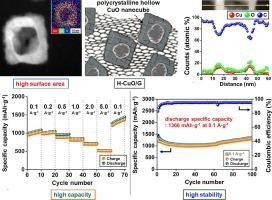高性能锂离子电池负极用石墨烯支撑的空心CuO纳米立方体协同设计
IF 5.9
3区 工程技术
Q1 CHEMISTRY, MULTIDISCIPLINARY
Journal of Industrial and Engineering Chemistry
Pub Date : 2025-02-17
DOI:10.1016/j.jiec.2025.02.035
引用次数: 0
摘要
长期以来,锂离子电池阳极的性能和寿命一直受到诸如体积变化、容量下降和充放电循环过程中电阻增加等挑战的阻碍。在这项研究中,我们提出了一种协同设计策略,通过合成石墨烯(H-CuO/G)支撑的空心CuO纳米立方体作为高性能阳极材料来克服这些限制。这种方法结合了中空纳米材料的结构优势,可以适应体积变化并提供丰富的活性位点,以及石墨烯优异的导电性和机械稳定性。该合成包括一种简单的多元醇方法,在石墨烯上产生均匀的Cu2O纳米立方体,然后利用Kirkendall效应进行连续的高温氧化过程,形成空心CuO结构。在0.1 a·G−1的电流密度下,H-CuO/G阳极获得了1366 mAh·G−1的放电容量,即使在5.0 a·G−1的高电流密度下,也能保持1000次循环的稳定性能。这种优异的性能归功于中空的CuO纳米立方体和石墨烯之间的协同作用,前者提供了高比表面积,后者增强了电子导电性和结构稳定性。本文章由计算机程序翻译,如有差异,请以英文原文为准。

Synergistic design of hollow CuO nanocubes supported on graphene for high-performance lithium-ion battery anodes
Improving the performance and lifespan of lithium-ion battery anodes has long been hindered by challenges such as volume changes, capacity degradation, and increased electrical resistance during charge–discharge cycles. In this study, we propose a synergistic design strategy to overcome these limitations by synthesizing hollow CuO nanocubes supported on graphene (H-CuO/G) as a high-performance anode material. This approach combines the structural benefits of hollow nanomaterials, which accommodate volume changes and provide abundant active sites, with the excellent electrical conductivity and mechanical stability of graphene. The synthesis involves a simple polyol method to create uniform Cu2O nanocubes supported on graphene, followed by a continuous high-temperature oxidation process utilizing the Kirkendall effect to form hollow CuO structures. The resulting H-CuO/G anode achieved a remarkably high discharge capacity of 1,366 mAh·g−1 at a current density of 0.1 A·g−1 and maintained stable cycling performance over 1,000 cycles, even at a high current density of 5.0 A·g−1. This outstanding performance is attributed to the synergistic effects between the hollow CuO nanocubes, which offer a high specific surface area, and the graphene support, which enhances electronic conductivity and structural stability.
求助全文
通过发布文献求助,成功后即可免费获取论文全文。
去求助
来源期刊
CiteScore
10.40
自引率
6.60%
发文量
639
审稿时长
29 days
期刊介绍:
Journal of Industrial and Engineering Chemistry is published monthly in English by the Korean Society of Industrial and Engineering Chemistry. JIEC brings together multidisciplinary interests in one journal and is to disseminate information on all aspects of research and development in industrial and engineering chemistry. Contributions in the form of research articles, short communications, notes and reviews are considered for publication. The editors welcome original contributions that have not been and are not to be published elsewhere. Instruction to authors and a manuscript submissions form are printed at the end of each issue. Bulk reprints of individual articles can be ordered. This publication is partially supported by Korea Research Foundation and the Korean Federation of Science and Technology Societies.

 求助内容:
求助内容: 应助结果提醒方式:
应助结果提醒方式:


